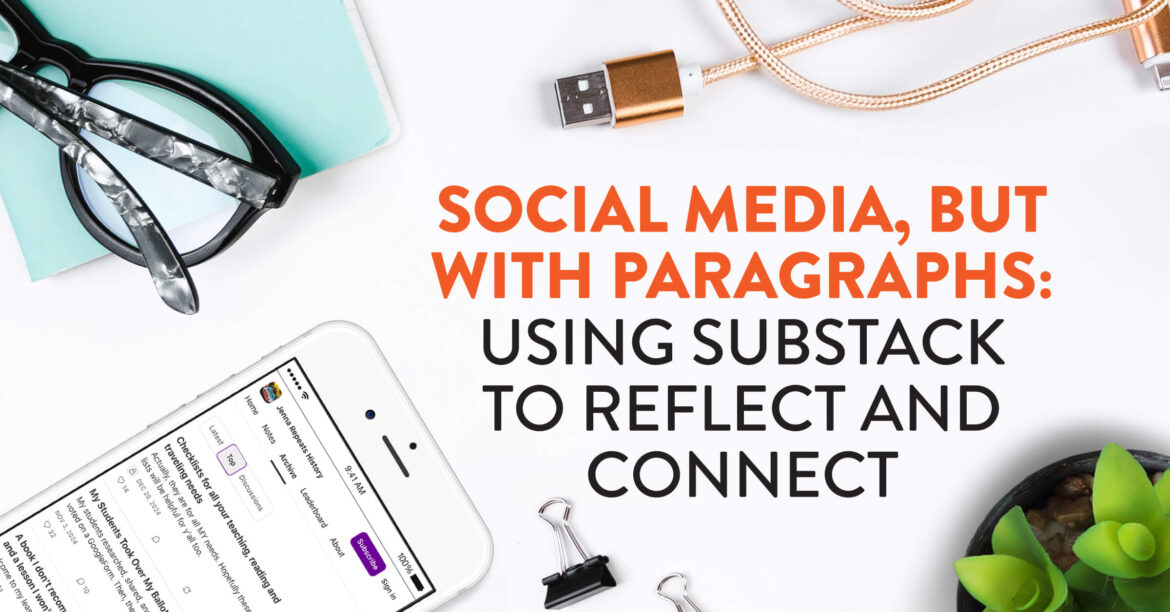Originally published in TEACH Magazine, September/October 2025 Issue
By Jenna Vandenberg
The summer before I started teaching, my cousin and fellow teacher gave me a beautiful notebook, and implored me to set aside time to write and reflect in it every day. She warned that classroom days would fly by quickly and at winter break, I’d have no idea how I’d gotten there. She told me to pause after the chaos of each day and take time to untangle all the student outbursts, questions, instances of non-compliance, and “ah-ha” moments.
To my shame, the notebook sat unused in my desk drawer.
My cousin was right. I have zero memories of that first year. I have no idea how I made it through.
Did I course correct during my second year? No.
For the better part of the next two decades, I spent my nearly depleted stores of after-school energy in IEP meetings or fighting with the copy machine rather than writing about my day. But after 17 years of mostly reflection-free teaching, I’ve finally found the perfect space to force myself to stop, step back, and think about what I’m teaching. That place is Substack.
What Is Substack?
Substack is an online platform for writers. Recalling the early days of blogging, anyone can sign up for an account and start writing. The platform allows readers to peruse a writer’s content online or receive newsletters via email. There are Substack newsletters about standing stones, political cartoons, the baseball scene in 19th-century Seattle, and much, much more.
There are also Substacks about teaching.
Using Substack to Reflect
For the past year, I’ve been using Substack to reflect on my educational practice. With the click of a few buttons, I created an account and told my three readers that I’d publish something new every Sunday.
And suddenly I found the impetus to reflect. I’d promised those readers a newsletter, so I had to find something to write about. Pretty soon those three readers doubled and tripled and quadrupled, and suddenly I had a hundred people who were expecting my thoughts.
Now, every Monday, after my 6th period class stacks their chairs and streams out into the hallway, I click the “new post” tab on the Substack creator dashboard. Then, I reflect. I add a few sentences or thoughts every day throughout the week, looking for connections and themes. Each Friday evening, during the hours between my kid’s cheer practice and my other kid’s drum lessons, I plug in my laptop and pull a cohesive story together from my fragments of reflections.
I write about lessons taught. I ponder the most effective way to grade essays. I revel in the insights gleaned from student discussions and I consider how I could have handled a conflict with more grace. I share lesson plans, slide decks, student worksheets, and links to resources. I make connections between history lessons, picture books, and places I’ve traveled.
Initially, it was the public accountability and novelty of a new system that finally forced me to make time for reflection. Then, connecting with readers and other teachers on Substack fueled my motivation. Now, I write and reflect because I genuinely enjoy it.
Benefits of Reflecting on Substack
Once I got into the habit of reflecting and writing, it became addictive. Just like my cousin promised, setting aside space to do so has made me a better and happier teacher and person. It’s forced me to consider different perspectives and evaluate teaching moves I made or didn’t make. Almost subconsciously, I feel myself planning to make better decisions in the classroom. When I write, I can find words to express the purpose of each assignment, which lets me better articulate that purpose to students.
Also, sharing lessons on Substack forces me to continually improve my slides and student worksheets. Much like reflecting, the best time to improve a lesson is right after you teach it, when moments of student confusion or impromptu explanations that finally click are still in your working memory.
Until recently, I rarely made time for lesson edits either. Sometimes I find myself handing out an assignment I’d created three years ago that still contains my old typos and the confusing metaphor I’d always meant to go back and fix. Now that I’m sharing assignments and slides on Substack, I’m finally fixing all those typos.
Connecting with Other Teachers
I’m not the only educator on Substack. Far from it. The platform is full of teachers, policy-makers, and education reporters from across the globe who share their own lesson plans, weigh in on debates about vouchers and AI, and muse about their days in the classroom.
Social media has long provided a place for teachers to connect, but I’d never really found an online community before. I’ve scrolled through Instagram posts of gorgeous elementary classrooms and laughed at teacher TikToks, but even in the halcyon days of Twitter #educhats, I never actually connected with people.
With Substack, I’ve finally figured out how. The platform’s long-form content allows for thoughtful and nuanced conversations, and I frequently find myself in comment sections chatting with other Substack teachers. Because I subscribe to my favorite educators, their newsletters come directly to my email instead of as fleeting posts in an endless feed.
When I read something that I want to think more about, I simply keep the article in my inbox before returning to comment—something that is harder to do when scrolling. Substack is perfect for people like me who want to engage with others online, but need a little extra time to think.
How to Get Started on Substack
As a reader, you don’t need to download an app or give your email address to anyone in order to read content on the platform. You can go directly to a Substack writer’s page where all their newsletters live.
Adrian Neibauer’s Substack is a great place to start. You’ll be prompted to enter your email address, but there is a “no thanks” option to bypass the email prompt and simply read. In addition to writing about his elementary classroom, Adrian recommends other education-related Substacks.
If you eventually want to subscribe to a newsletter you love, then you’ll need to enter your email address. You’ll likely need to choose whether you want to pay for the Substack or read for free. Simply click the free option and you are subscribed! While some newsletters are behind a paywall, most Substackers in the education sphere keep their content free.
Substack also has an app and a social media section called Notes that allows users to share links, pieces of newsletters, pictures, videos, and other content, much like X. It can be a good way to discover other Substacks and get quick tips or pieces of information, but is not necessary.
If you want to get started on Substack as a writer, setting up a newsletter is easy. Think of a name, upload a picture, and start writing! Unlike other newsletter options such as Mailchimp or Constant Contact, Substack is free and doesn’t require writers to disclose a physical address to their readers. When readers sign up for your newsletter, their email address goes directly to you the creator, so writers can take their audience with them if they decide to leave the platform (unlike TikTok, Meta, or X).
That notebook my cousin bought me decades ago is long gone, lost amid school transfers and cross-country moves. But I do have a new notebook these days that I carry with me and use in WiFi-free spaces. It’s full of Substack ideas.
Jenna Vandenberg is a mom and a public school teacher in Everett, WA. After 6th period ends, she’s a Substack writer at Jenna Repeats History.



